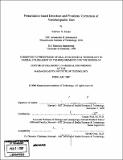Perturbation-based detection and prosthetic correction of vestibulopathic gait
Author(s)
Sienko, Kathleen Helen, 1976-
DownloadFull printable version (14.62Mb)
Other Contributors
Harvard University--MIT Division of Health Sciences and Technology.
Advisor
Conrad Wall, III.
Terms of use
Metadata
Show full item recordAbstract
While being able to balance is something most of us take for granted, each year approximately 400,000 Americans are diagnosed with a balance disorder. In order to prevent fall-related injuries due to postural instability, it is important to create both diagnosis techniques so that therapy can be applied before a fall occurs and devices which can aid the balance-impaired population. The aims of this research are twofold: 1) to develop metrics that quantify the locomotor stability of individuals with reduced vestibular function and 2) to assess the capability of a noninvasive vibrotactile balance prosthesis for improving postural and gait stability. The clinical standards of practice for assessing vestibular deficiency include testing postural stability while standing but not during locomotion. This research examines one prospective locomotor-based technique involving the analysis of postural recovery from controlled surface perturbations. The research also investigates the use of a novel wearable vibrotactile sensory substitution device for enhanced postural and locomotor stability. The balance prosthesis is composed of an inertial motion-sensing system mounted on the lower back, a vibrotactile display worn around the torso, and a computer controller. (cont.) It can serve as a permanent or temporary replacement of motion cues, a tool for vestibular rehabilitation, or an additional sensory channel for military troops, pilots, and astronauts. This research demonstrates that well-compensated vestibulopathic patients can be differentiated from young and age-matched controls during over ground locomotion based on step width variability. Prior to this research, unilateral and bilateral vestibulopathic patients donning the vibrotactile balance prosthesis have demonstrated increased postural stability during single-axis support surface perturbations using single-axis sway information. This work shows that multi-directional vibrotactile tilt feedback reduces postural sway during multi-directional support surface perturbations, and has both short- and long-term effects on increasing postural stability. Finally, this research demonstrates for the first time that medial-lateral (M/L) tilt feedback can be used by balance-deficient subjects to reduce factors associated with fall risk (M/L tilt and M/L step width variability) during various locomotor tasks.
Description
Thesis (Ph. D.)--Harvard-MIT Division of Health Sciences and Technology, February 2007. Includes bibliographical references.
Date issued
2007Department
Harvard University--MIT Division of Health Sciences and TechnologyPublisher
Massachusetts Institute of Technology
Keywords
Harvard University--MIT Division of Health Sciences and Technology.